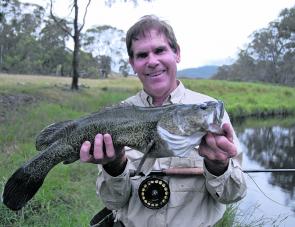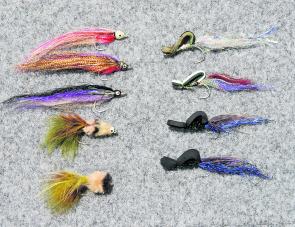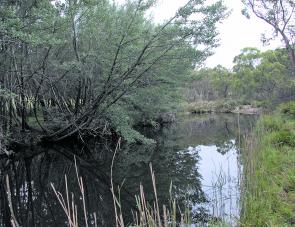I caught my first Murray cod on fly tackle back in 1987 in a New England stream. Since then I have taken them in various waters around Canberra out to Bonshaw in New South Wales, as well as around Stanthorpe in good old Queensland.
The point is not that I’m a great cod angler, more that cod are widespread, and if conditions are right can be very willing starters on the long rod.
Making a start on your own cod on fly gear should involve taking two things into consideration. First, the flies used to take cod need to be pretty big (on 3/0-4/0 hooks) in order to be noticed.
Secondly, while a lot of cod taken on fly tackle will be little tackers that are barely legal (55cm in NSW and Victoria, 60cm in Qld) there will always be a big bruiser lurking at a pool’s head or near some enticing cover that will clean up too light tackle in an instant.
In smaller cod waters, an 8wt rod will handle a big bulky air resistant fly and can then have enough power to tackle a larger fish when hooked. In larger waters such as the Dumaresq, Macintyre, and Severn where cod grow much larger I advocate a 9-10wt outfit.
An interesting aspect of cod behaviour that receives little press coverage is that an individual fish will fight far more strongly than another, and, when conditions fire them up – such as fresh in the stream or a storm not far away – cod can hit an offering very hard, punching well above their weight in the net.
Much like barra, these apex predators are most active when there’s dull light or darkness and can be taken on a surface fly on a floating line at these times while all purpose general fishing will involve an intermediate sink rate line or a sink tip job. Obviously, two fly lines will be an asset but if you only have a floating line stay with it and when the day has brightened and there’s little chance of surface action, rub a bit of good old mud along the leader and the fly will sink quite well.
On the subject of leader, a little less than a rod’s length is ideal with some 30kg Penn 10 X or similar material attached to the fly line, then a couple of step down sections terminating in 10kg at the fly. Cod have sharp, raspy teeth, which can chafe a leader quickly so it’s smart to check the leader tip after each fish. Personally, I always use FC100 as my tippet – I love that extra tough fluorocarbon!
For dry fly work, a Gartside Gurgler is all that is required with the smart angler tying a few of these up on different coloured foam sections, with differing bodies and tails as well. Sometimes cod are attracted to a quite dull offering, other times a shiny one with plenty of flash in the body or tail comes up trumps. There’s a definite bonus in using a dark fly on or after dusk, as it will silhouette far better than a pale offering. I love purple.
Wet fly work can involve large Clousers, big Deceivers, Bush Pigs, and of course a selection of Toads. The Toads are one of the most effective flies for ambush style predators going. Barra love them too and Mr Google has plenty of tying tips. Remember, if the water is somewhat dirty, a fly with plenty of flash about it will be most effective.
I believe that over all colour is not as important as the method of working a fly. As apex predators, cod eat everything that swim, falls in, or is taking a bath (such as a hapless bird) yet nothing moves very quickly so a fully sunken wet fly needs to be retrieved in very slow jerks and twitches with the fly line under control at all times to prevent slack. The idea is to land it with a decent plop to attract a fish in the first instance, give it a short time to sink then retrieve it in the slowest of little twitches with frequent pauses in between the action.
Surface flies are worked similarly with some small chugs to start with then a series of tiny twitches with a few stops and starts in between. These fish take dry flies with a very loud slurp, not the sort of ‘boof’ we associate with barra, but a loud sucking sound nonetheless. The interesting thing is that if a cod misses a fly (which they seem to do a lot) they won’t usually come back for another go. Changing you fly for another is a good option in this scenario.
The really important question now arises. Where do we find Murray cod? Plenty of impoundments are stocked with them but there’s always a lot of water between fish, making fly fishing a very difficult prospect.
Streams, smaller ones in particular, are the smart move. The keen angler could start around Stanthorpe up on the Granite Belt and then look at virtually every waterway from that point south to Armidale, as well as to their western counterparts.
The point is that the western watersheds are holding the cod, so even a small Granite Belt stream can be well worth some exploration twenty or so kilometres from where one can jump across it with ease. Stocking groups are very active in these areas and the fish numbers are kept well supplemented.
The best places to fish are where there’s some water depth plus good cover to hold these wide mouthed fish that simply wait for tucker to come past.
In all, cod on fly gear are a lot of fun, especially when using the dry fly and waiting for that explosive take!
Reads: 5938
This cod, while by no means a large one, hit particularly hard and put up a solid fight on a stormy afternoon

A selection of the author’s rough but effective cod flies. Note the Toads at the bottom and the purple Gartside Gurglers (on the right), these are excellent for surface work.

A section of small stream cod habitat: where branches overhang is a great place to drop a fly.




